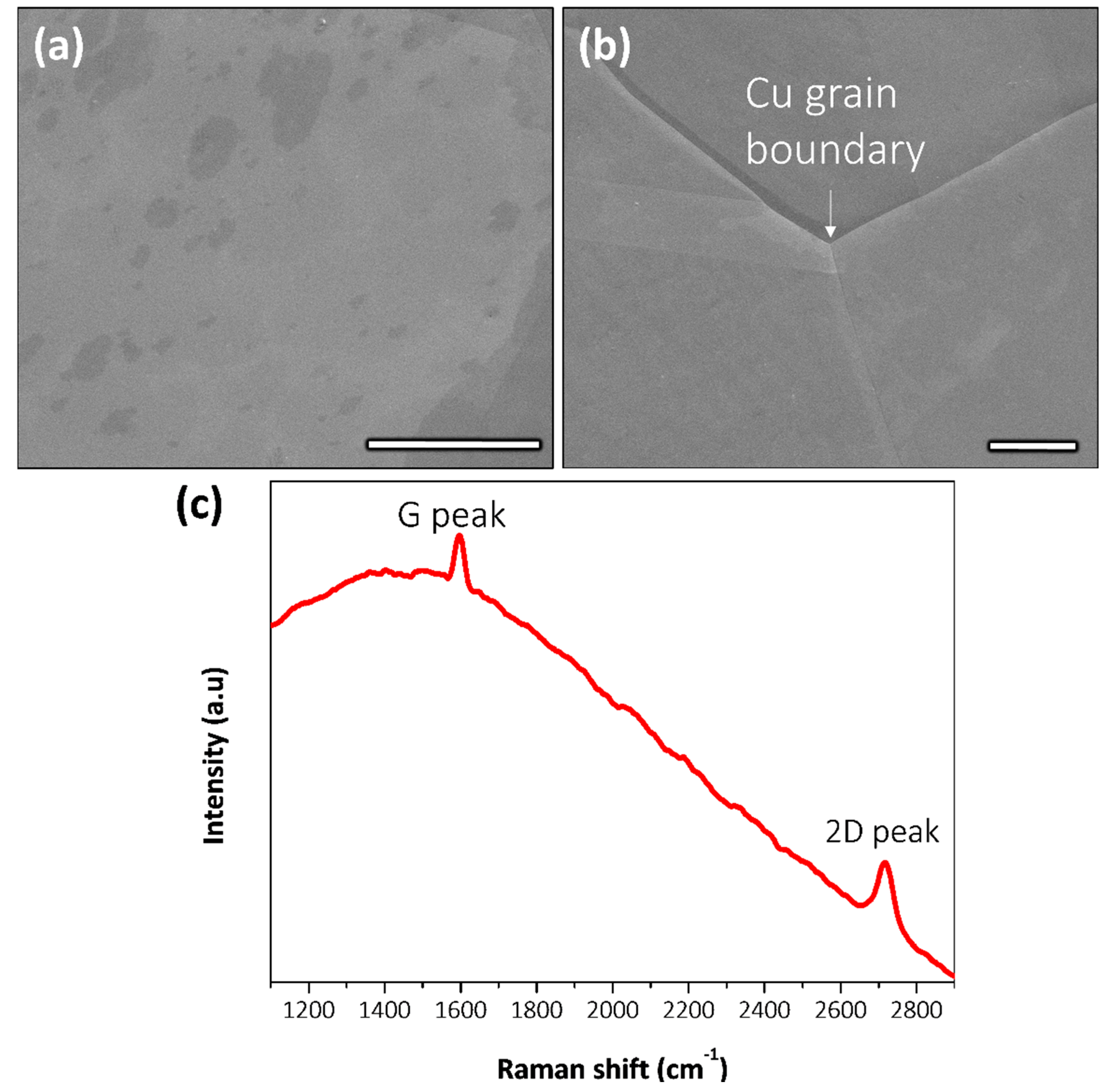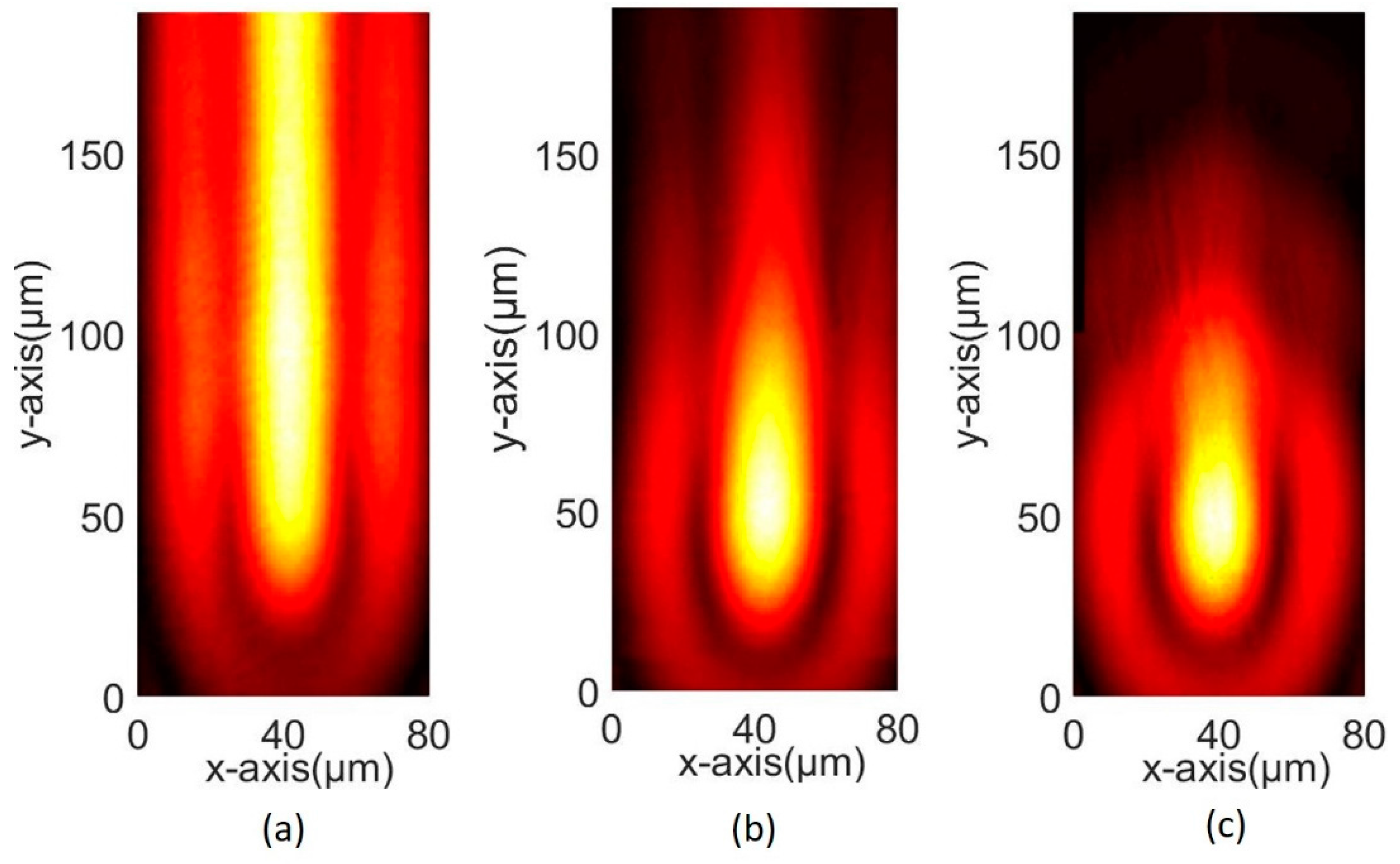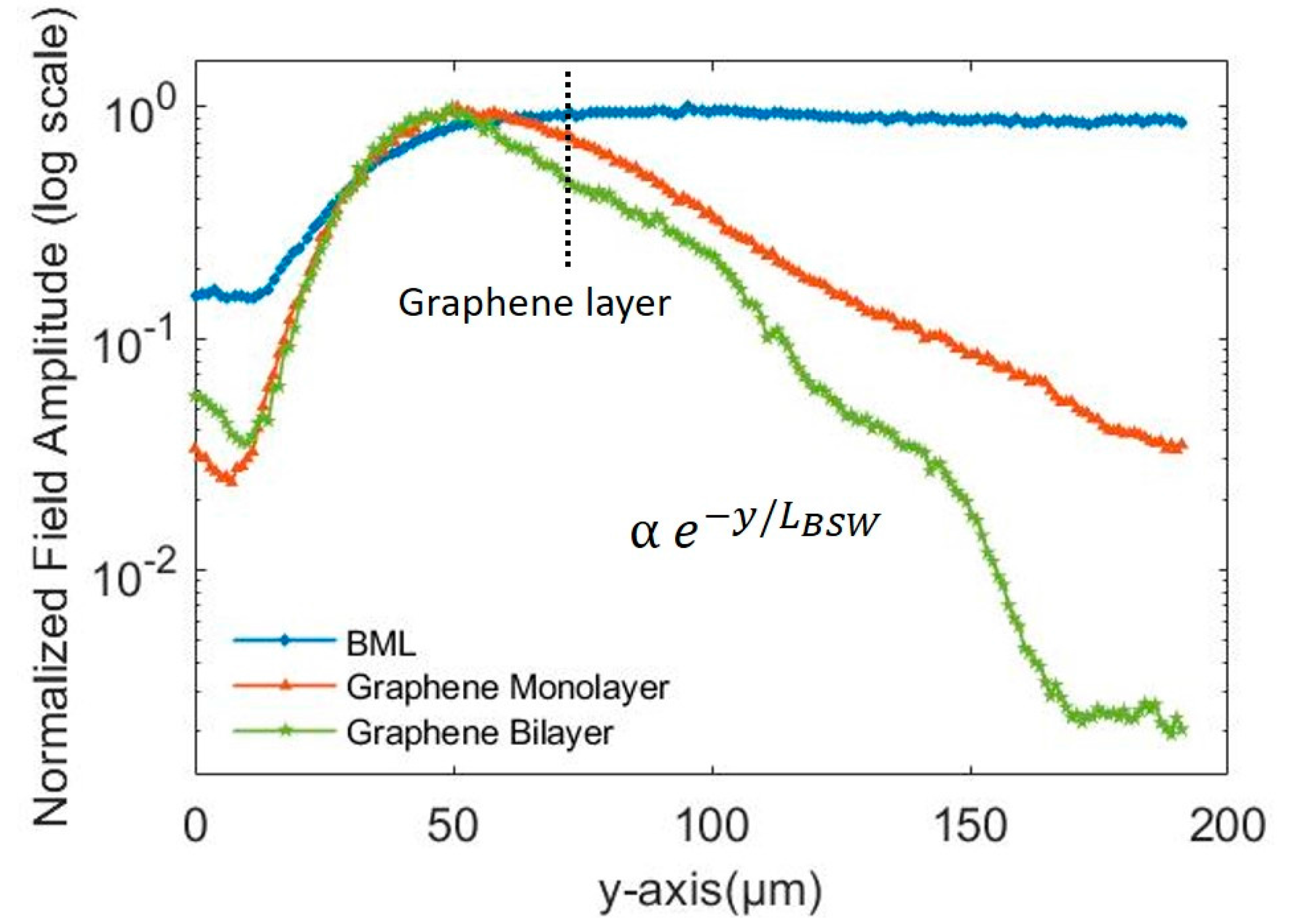Bloch Surface Waves Using Graphene Layers: An Approach toward In-Plane Photodetectors
Abstract
:1. Introduction
2. Materials and Methods
3. Results and Discussion
4. Conclusions
Acknowledgments
Author Contributions
Conflicts of Interest
References
- Yeh, P.; Yariv, A.; Cho, A.Y. Optical surface waves in periodic layered media. Appl. Phys. Lett. 1978, 32, 104–105. [Google Scholar] [CrossRef]
- Liscidini, M.; Sipe, J.E. Enhancement of diffraction for biosensing applications via Bloch surface waves. Appl. Phys. Lett. 2007, 91, 253125. [Google Scholar] [CrossRef]
- Descrovi, E.; Frascella, F.; Sciacca, B.; Geobaldo, F.; Dominici, L.; Michelotti, F. Coupling of surface waves in highly defined one-dimensional porous silicon photonic crystals for gas sensing applications. Appl. Phys. Lett. 2007, 91, 241109. [Google Scholar] [CrossRef]
- Giorgis, F.; Descrovi, E.; Summonte, C.; Dominici, L.; Michelotti, F. Experimental determination of the sensitivity of Bloch surface waves based sensors. Opt. Express 2010, 18, 8087–8093. [Google Scholar] [CrossRef] [PubMed]
- Yu, L.; Barakat, E.; Sfez, T.; Hvozdara, L.; Di Francesco, J.; Herzig, H.P. Manipulating Bloch surface waves in 2D: A platform concept-based flat lens. Light Sci. Appl. 2014, 3, 124. [Google Scholar] [CrossRef]
- Soboleva, I.V.; Descrovi, E.; Summonte, C.; Fedyanin, A.A.; Giorgis, F. Fluorescence emission enhanced by surface electromagnetic waves on one-dimensional photonic crystals. Appl. Phys. Lett. 2009, 94, 231122. [Google Scholar] [CrossRef]
- Ulrich, R. Theory of the prism-film coupler by plane-wave analysis. J. Opt. Soc. Am. 1970, 60, 1337–1350. [Google Scholar] [CrossRef]
- Dubey, R.; Barakat, E.; Häyrinen, M.; Roussey, M.; Honkanen, S.; Kuittinen, M.; Herzig, H.P. Experimental investigation of the propagation properties of Bloch surface waves on dielectric multilayer platform. J. Eur. Opt. Soc. 2017, 13, 1–9. [Google Scholar] [CrossRef]
- Khan, M.U.; Corbett, B. Bloch surface wave structures for high sensitivity detection and compact waveguiding. Sci. Technol. Adv. Mater. 2016, 17, 398–409. [Google Scholar] [CrossRef] [PubMed]
- Dubey, R. Near-Field Characterization of Bloch Surface Waves Based 2D Optical Components. Ph.D. Thesis, École Polytechnique Fédérale de Lausanne, Lausanne, Switzerland, 2017. [Google Scholar]
- Konopsky, V.N.; Alieva, E.V. Photonic crystal surface waves for optical biosensors. Anal. Chem. 2007, 79, 4729–4735. [Google Scholar] [CrossRef] [PubMed]
- Robertson, W.M. Experimental measurement of the effect of termination on surface electromagnetic waves in one-dimensional photonic bandgap arrays. J. Light. Technol. 1999, 17, 2013–2017. [Google Scholar] [CrossRef]
- Herzig, H.P.; Barakat, E.; Dubey, R.; Kim, M.-S. Optics in 2D Bloch surface wave phenomena and applications. In Proceedings of the 15th Workshop on Information Optics (WIO), Barcelona, Spain, 11–15 July 2016. [Google Scholar] [CrossRef]
- Dubey, R.; Barakat, E.; Herzig, H.P. Bloch surface waves based platform for integrated optics. In Proceedings of the IEEE Photonics Conference, Reston, VA, USA, 4–8 October 2015. [Google Scholar] [CrossRef]
- Herzig, H.P.; Barakat, E.; Yu, L.; Dubey, R. Bloch surface waves, a 2D platform for planar optical integration. In Proceedings of the 13th Workshop on Information Optics (WIO), Neuchatel, Switzerland, 7–11 July 2014. [Google Scholar] [CrossRef]
- Sfez, T.; Descrovi, E.; Yu, L.; Quaglio, M.; Dominici, L.; Nakagawa, W.; Michelotti, F.; Giorgis, F.; Herzig, H.P. Two-dimensional optics on silicon nitride multilayer: Refraction of Bloch surface waves. Appl. Phys. Lett. 2010, 96, 151101. [Google Scholar] [CrossRef]
- Sfez, T.; Descrovi, E.; Yu, L.; Brunazzo, D.; Quaglio, M.; Dominici, L.; Herzig, H.P. Bloch surface waves in ultrathin waveguides: Near-field investigation of mode polarization and propagation. J. Opt. Soc. Am. A 2010, 27, 1617–1625. [Google Scholar] [CrossRef]
- Angelini, A.; Lamberti, A.; Ricciardi, S.; Frascella, F.; Munzert, P.; Leo, N.D.; Descrovi, E. In-plane 2D focusing of surface waves by ultrathin refractive structures. Opt. Lett. 2014, 39, 6391–6394. [Google Scholar] [CrossRef] [PubMed]
- Dubey, R.; Lahijani, B.V.; Barakat, E.; Häyrinen, M.; Roussey, M.; Kuittinen, M.; Herzig, H.P. Near-field characterization of a Bloch-surfacewave-based 2D disk Resonator. Opt. Lett. 2016, 41, 4867–4870. [Google Scholar] [CrossRef] [PubMed]
- Lahijani, B.V.; Ghavifekr, H.B.; Dubey, R.; Kim, M.-S.; Vartiainen, I.; Roussey, M.; Herzig, H.P. Experimental demonstration of critical coupling of whispering gallery mode cavities on Bloch surface wave platform. Opt. Lett. 2017, 42, 5137–5140. [Google Scholar] [CrossRef] [PubMed]
- Dubey, R.; Lahijani, B.V.; Häyrinen, M.; Roussey, M.; Kuittinen, M.; Herzig, H.P. Ultra-thin Bloch surface waves based reflector at telecommunication wavelength. Photonics Res. 2017, 5, 494–499. [Google Scholar] [CrossRef]
- Kim, M.-S.; Dubey, R.; Barakat, E.; Herzig, H.P. Nano-thin 2D axicon generating nondiffracting surface waves. In Proceedings of the Optical MEMS and Nanophotonics (OMN), Singapore, 31 July–4 August 2016. [Google Scholar] [CrossRef]
- Kim, M.-S.; Barakat, E.; Dubey, R.; Scharf, T.; Herzig, H.P. Nondiffracting Bloch surface wave: 2D quasi-Bessel-Gauss beam. In Proceedings of the OSA CLEO Pacific Rim Conference, Busan, Korea, 24–28 August 2015. [Google Scholar] [CrossRef]
- Dubey, R.; Lahijani, B.V.; Kim, M.-S.; Barakat, E.; Häyrinen, M.; Roussey, M.; Kuittinen, M.; Herzig, H.P. Near-field investigation of Bloch surface wave based 2D optical components. In Proceedings of the SPIE Photonics West 10106, San Francisco, CA, USA, 16 February 2017. [Google Scholar] [CrossRef]
- Wang, R.; Wang, Y.; Zhang, D.; Si, G.; Zhu, L.; Du, L.; Kou, S.; Badugu, R.; Rosenfeld, M.; Lin, J.; et al. Diffraction-Free Bloch Surface Waves. ACS Nano 2017, 11, 5383–5390. [Google Scholar] [CrossRef] [PubMed]
- Kim, M.-S.; Lahijani, B.V.; Descharmes, N.; Straubel, J.; Negredo, F.; Rockstuhl, C.; Häyrinen, M.; Roussey, M.; Kuittinen, M.; Herzig, H.P. Subwavelength focusing of Bloch surface waves. ACS Photonics 2017, 4, 1477–1483. [Google Scholar] [CrossRef]
- Doskolovich, L.L.; Bezus, E.A.; Bykov, D.A.; Soifer, V.A. Spatial differentiation of Bloch surface wave beams using an on-chip phase-shifted Bragg grating. J. Opt. 2016, 18, 115006. [Google Scholar] [CrossRef]
- Kovalevich, T.; Boyer, P.; Suarez, M.; Salut, R.; Kim, M.S.; Herzig, H.P.; Bernal, M.P.; Grosjean, T. Polarization controlled directional propagation of Bloch surface wave. Opt. Express 2017, 25, 5710–5715. [Google Scholar] [CrossRef] [PubMed]
- Angelini, A.; Barakat, E.; Munzert, P.; Boarino, L.; De Leo, N.; Enrico, E.; Giorgis, F.; Herzig, H.P.; Pirri, C.F.; Descrovi, E. Focusing and extraction of light mediated by Bloch surface waves. Sci. Rep. 2014, 4, 5428. [Google Scholar] [CrossRef] [PubMed]
- Kovalevich, T.; Ndao, A.; Suarez, M.; Tumenas, S.; Balevicius, Z.; Ramanavicius, A.; Baleviciute, I.; Häyrinen, M.; Roussey, M.; Kuittinen, M.; et al. Tunable Bloch surface waves in anisotropic photonic crystals based on lithium niobate thin films. Opt. Lett. 2016, 41, 5616–5619. [Google Scholar] [CrossRef] [PubMed]
- Kovalevich, T.; Kim, M.S.; Belharet, D.; Robert, L.; Herzig, H.P.; Grosjean, T.; Bernal, M.P. Experimental evidence of Bloch surface waves on photonic crystals with thin film LiNbO3 as a top layer. Photonics Res. 2017, 5, 649–653. [Google Scholar] [CrossRef]
- Liang, G.; Neophytou, N.; Nikonov, D.E.; Lundstrom, M.S. Performance projections for ballistic graphene nanoribbon field-effect transistors. IEEE Trans. Electron. Devices 2007, 54, 677–682. [Google Scholar] [CrossRef]
- Sreekanth, K.V.; Zeng, S.; Shang, J.; Yong, K.-T.; Yu, T. Excitation of surface electromagnetic waves in a graphene-based Bragg grating. Sci. Rep. 2012, 2, 737. [Google Scholar] [CrossRef] [PubMed]
- Schuler, S.; Schall, D.; Neumaier, D.; Dobusch, L.; Bethge, O.; Schwarz, B.; Krall, M.; Mueller, T. Controlled Generation of a p-n Junction in a Waveguide Integrated Graphene Photodetector. Nano Lett. 2016, 16, 7107–7112. [Google Scholar] [CrossRef] [PubMed]
- Zhou, Y.; Wang, C.; Xu, D.-H.; Fan, R.-H.; Zhang, K.; Peng, R.-W.; Hu, Q.; Wang, M. Tuning the dispersion relation of a plasmonic waveguide via graphene contact. Europhys. Lett. 2014, 107, 34007. [Google Scholar] [CrossRef]
- Merano, M. Transverse electric surface mode in atomically thin Boron–Nitride. Opt. Lett. 2016, 41, 2668–2671. [Google Scholar] [CrossRef] [PubMed]
- Marchena, M.; Janner, D.; Chen, T.L.; Finazzi, V.; Pruneri, V. Low temperature direct growth of graphene patterns on flexible glass substrates catalysed by a sacrificial ultrathin Ni film. Opt. Mater. Express 2016, 6, 2487–2507. [Google Scholar] [CrossRef]
- Kretschmann, E.; Raether, H. Radiative decay of nonradiative surface plasmons excited by light. Z. Naturforsch. 1968, 23, 2135–2136. [Google Scholar] [CrossRef]
- Tien, P.K.; Ulrich, R.; Martin, R.J. Modes of propagating light waves in thin deposited semiconductor films. Appl. Phys. Lett. 1969, 14, 291–294. [Google Scholar] [CrossRef]
- Konopsky, V.N.; Alieva, E.V. Observation of fine interference structures at total internal reflection of focused light beams. Phys. Rev. A 2012, 86, 063807. [Google Scholar] [CrossRef]
- Rodrigo, D.; Tittl, A.; Limaj, O.; de Abajo, F.J.G.; Pruneri, V.; Altug, H. Double-layer graphene for enhanced tunable infrared plasmonics. Light Sci. Appl. 2017, 6, 16277. [Google Scholar] [CrossRef]
- Gassenq, A.; Hattasan, N.; Cerutti, L.; Rodriguez, J.B.; Tournié, E.; Roelkens, G. Study of evanescently-coupled and grating assisted GaInAsSb photodiodes integrated on a silicon photonic chip. Opt. Express 2012, 20, 11665–11672. [Google Scholar] [CrossRef] [PubMed]





© 2018 by the authors. Licensee MDPI, Basel, Switzerland. This article is an open access article distributed under the terms and conditions of the Creative Commons Attribution (CC BY) license (http://creativecommons.org/licenses/by/4.0/).
Share and Cite
Dubey, R.; Marchena, M.; Vosoughi Lahijani, B.; Kim, M.-S.; Pruneri, V.; Herzig, H.P. Bloch Surface Waves Using Graphene Layers: An Approach toward In-Plane Photodetectors. Appl. Sci. 2018, 8, 390. https://doi.org/10.3390/app8030390
Dubey R, Marchena M, Vosoughi Lahijani B, Kim M-S, Pruneri V, Herzig HP. Bloch Surface Waves Using Graphene Layers: An Approach toward In-Plane Photodetectors. Applied Sciences. 2018; 8(3):390. https://doi.org/10.3390/app8030390
Chicago/Turabian StyleDubey, Richa, Miriam Marchena, Babak Vosoughi Lahijani, Myun-Sik Kim, Valerio Pruneri, and Hans Peter Herzig. 2018. "Bloch Surface Waves Using Graphene Layers: An Approach toward In-Plane Photodetectors" Applied Sciences 8, no. 3: 390. https://doi.org/10.3390/app8030390




